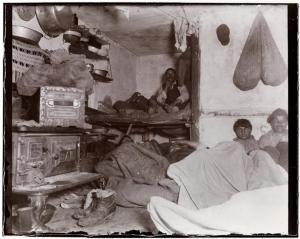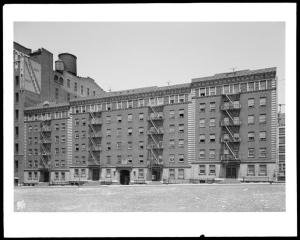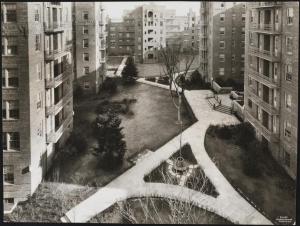MCNY Blog: New York Stories
Iconic photos of a changing city, and commentary on our Collections & Exhibitions from the crew at MCNY.org
Affordable New York: Phipps Houses
The names of Andrew Carnegie and Henry Clay Frick are well known in New York City and beyond for Carnegie Hall and for the Frick Collection. Though the institutions built by these two steel magnates are important to the city’s cultural identity, the organization built by their lesser known (but just as wealthy) associate, Henry Phipps, has had, and continues to have, a more material affect on the lives of New Yorkers. His legacy, Phipps Houses, is the oldest non-profit developer of affordable housing, erecting its first buildings in 1906 and actively developing and managing properties today.

Jacob A. (Jacob August) Riis (1849-1914), Lodgers in a crowded Bayard Street tenement – “Five cents a spot,” ca. 1890. Museum of the City of New York. 90.13.4.158
At the end of the 19th century, Jacob A. Riis and other activists were drawing public attention to the often appalling conditions of recent immigrants and working poor in tenements. Riis’s photographs vividly illustrated the unsanitary, crowded, dark, and claustrophobic apartments that housed some of the city’s most vulnerable residents. Lack of ventilation contributed to rampant tuberculosis and crude sanitation to a whole host of other health risks.
Phipps, originally a bookkeeper who had himself grown up in a Pittsburgh tenement, gained between $50 and $70 million (accounts differ) when Carnegie Steel and J.P. Morgan merged. Concerned about the welfare of the city’s poor, he initially set aside a relatively small portion of this fortune–$1 million–and began Phipps Houses’ first development, on East 31st Street between First and Second Avenues, now the site of Kips Bay Towers.

Wurts Bros. (New York, N.Y.), 325-335 East 31st Street. Phipps tenements, ca. 1905. Museum of the City of New York. X2010.7.1.417

Wurts Bros. (New York, N.Y.), Phipps Residences. Detail of one arch, 331 East 31st Street, ca. 1931. Museum of the City of New York. X2010.7.2.5216
The three six-story buildings opened to tenants in 1906 and featured an interior courtyard to provide natural light and ventilation, and dramatic four-story archways that served as community spaces and, as Christopher Gray wrote in his 2003 Streetscapes column in the New York Times, “to keep the residents away from the corrupting influence of the street.”

Wurts Bros. (New York, N.Y.), 235-247 West 63rd Street. Phipps Houses, 1944. Museum of the City of New York. X2010.7.1.8533
Work began almost immediately on a new development on West 63rd Street between Amsterdam and West End Avenues. Then known as San Juan Hill, the surrounding neighborhood was predominantly populated by African Americans, many of whom had recently come to New York to escape the Jim Crow south and seek better economic opportunities, and who met with intensive housing discrimination. The buildings on West 63rd were intended for and populated by black tenants, in contrast to the all-white buildings on 31st Street. Phipps Houses sold this Midtown complex in the 1950s in order to finance other developments. The buildings are still standing, with a two-story addition.

Wurts Bros. (New York, N.Y.), Sunnyside. Phipps garden apartments. Exterior garden view, 1932. Museum of the City of New York. X2010.7.2.4982
The organization didn’t begin its next project until a couple of decades later: Phipps Garden Apartments on the border between Woodside and Sunnyside, Queens, opened in 1931, with a second, adjacent development opening in 1935. Unlike the Manhattan projects, the Garden Apartments were intended for middle income white collar workers, were larger, and featured amenities like radio aerial outlets in the living rooms and sound proofing. Four- and six-story buildings housing 472 apartments surrounded extensive interior park-like gardens designed by landscape architect Marjorie Sewell Cautley. Public space was set aside in the buildings for things like a social hall and nursery programs, and Phipps Houses constructed a playground across the street.

Wurts Bros. (New York, N.Y.), Sunnyside. Phipps garden apartments. Exterior street view, 1932. Museum of the City of New York. X2010.7.2.14066

Wurts Bros. (New York, N.Y.), Sunnyside. Phipps garden apartments. Exterior, garden with women and children, 1933. Museum of the City of New York. X2010.7.2.5583
For rare 1930s film footage of the complex and its residents, see the Sunnyside Oral History Program’s YouTube video.
Phipps Houses continues to construct affordable housing projects all over the city, and also offers community health, social service, and education initiatives through its Phipps Neighborhoods program. You can learn more about the organization and see a list of its affordable housing projects on their website.
This blog post is presented in conjunction with the City Museum’s exhibition, Affordable New York: A Housing Legacy, on view until February 16, 2016. If you or a family member lives or lived in the Phipps Garden Apartments (now Sunnyside Garden Apartments), please share your memories in the comments section. We look forward to hearing from you!


I was born at 331-335 E.31 st. We lived on the 4 floor, the rooftop Terrace was our last play area.We lived there till the planned Midtown Tunnel was built and Phipps apts were demolished. My First Kindergarten was in the building. My mother lived to age 98 And never ever forgot “the Phipps”!! The BEST